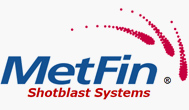Preventing Exfoliation in Stainless Steel Tubes: The MetFin Model MTP 9003, designed and built for success.
The utility industry’s pursuit of higher efficiency has increased the use of stainless steel superheaters. A pattern of early boiler tube failures (BTF) associated with stainless steel superheaters in both subcritical and supercritical zones has been associated with the process known as exfoliation. Detailed industry studies have shown that exfoliation or duplex scale forms on the steam side of tubes at high temperatures. Under certain conditions the amount of scale buildup can block steam flow and lead to a tube failure. Tube failures are expensive for the utility operator in terms of repair costs and downtime lost revenue; estimated in the millions of dollars per hour.
Best Method to reduce tube failure: Pre-Fabrication Shot Peening
Industry experts have identified different ways of dealing with exfoliation including using higher cost alloy tubes or planned maintenance programs to blow down tube systems purging scale build up before a failure occurs. But perhaps the best and most cost effective way to prevent exfoliation on the inside surface of stainless steel tubes is cold working the inner surface, more commonly known as shot peening the inside of tubes prior to fabrication.
How does shot peening or cold working the inside of tube alloys such as 347H and 304H prevent exfoliation? Shot peening compresses the inside surface of boiler tubes, creating dislocations or slip bands. In stainless steel, these bands act as diffusion paths allowing the corrosion preventing Cr to travel to the surface and form a protective spinel layer at a faster rate. It is this spinel layer that effectively prevents the formation of magnetite on the inside surface of the tubes. Simply put, proper shot peening allows chromium to migrate to the surface forming a faster and thicker spinel layer to develop and provides a barrier that inhibits a magnetite layer from forming on the inside surface of the tube. It is the magnetite layer that spalls off the surface of the inner tube wall which causes the exfoliation and potential for tube blockage. A thorough, repeatable process of cold working or compressing the inner surface of stainless steel tubes eliminates the areas where magnetite can form thus providing a low cost, safe and reliable means of preventing exfoliation of oxide scales in boiler tubes.
Post Fabrication vs. Pre-Fabrication
Now that the utility industry has recognized the importance of shot peening as a reliable method of preventing exfoliation of oxide scales, what is the best method for producing quality shot peened sections of stainless steel tube? There are two distinctly different processes for shot peening the inner diameters of boiler tubes; post fabrication and pre-fabrication. Both processes use compressed air to propel the peening media, (normally a stainless steel ball known as shot), through a hose or lance directed out of a nozzle at the target surface. That is where the similarity ends.
The post fabrication peening process uses a rubber hose and nozzle to spray a 360 degree stream of peening media at the inside tube surface. It is impossible to assure that the media is distributed evenly around the entire circumference of the tube. This is commonly referred to as coverage and poor coverage through post fabrication shot peening allows oxidation to proceed. Post fabrication peening equipment lacks the process controls necessary to ensure a uniformed surface and consistent depth of compression, the primary criteria for the process to be successful.
The pre-fabrication peening process uses a rigid lance and nozzle that directs the stream of peening media in a fixed direction as straight tubes are rotated and the lance nozzle slowly traverses the length of the tube. This assures that the tube inner surface is evenly peened. By continuously monitoring and controlling all of the critical process parameters: media flow, air pressure, lance and tube movement; the outcome of the process is assured and repeatable.
Certification
As industry specifications are strictly defined, certification of cold worked stainless steel tubes will be demanded by utility and government regulatory agencies. Specifications will most certainly require a minimum guarantee of depth of compression, hardness and coverage. The equipment that can provide the level of process control and productivity required to meet these specifications will be demanded by the utility industry and those companies which serve the utility industry. This type of equipment is now available from Metal Finish Equipment and Supply Company, Inc. located in Suffield, CT, USA and includes the features that a quality peening system must have:
- Pre-Fabrication Tube Peening Equipment should be capable of processing tubes with ID range of 25 to 80mm and a length range of 6 to 15 meters.
- Capability of peening 100% of the tube ID from end to end.
- Electrical controls that monitor all input variables including air pressure, media flow, rotation and linear speed. The electrical controls must be able to detect faults and pinpoint the location on the tubes where faults may have occurred and provide the mechanisms to correct.
- System checks that measure intensity.
- Mechanical system that ensures smooth rotational and linear movements.
- Media collection and classification system that ensures quality shot is impacting the inner tube wall.
- Pneumatic system that ensures a constant and even pressure that can be precisely controlled from an operator panel.
Productivity
Now that the equipment parameters have been discussed, the question of productivity must be addressed. Since several thousand linear meters of tube can be required for a particular superheater, the pre-fabrication peening equipment must have material handling capabilities that allow for completely automated loading, processing and unloading of the tubes. Compressed air is expensive and a system that can prevent the need for over peening or re-peening tubes is critical to keeping processing costs stable.
For more information on proper pre-fabrication multiple tube shot peening equipment visit www.metfin.com/contact


